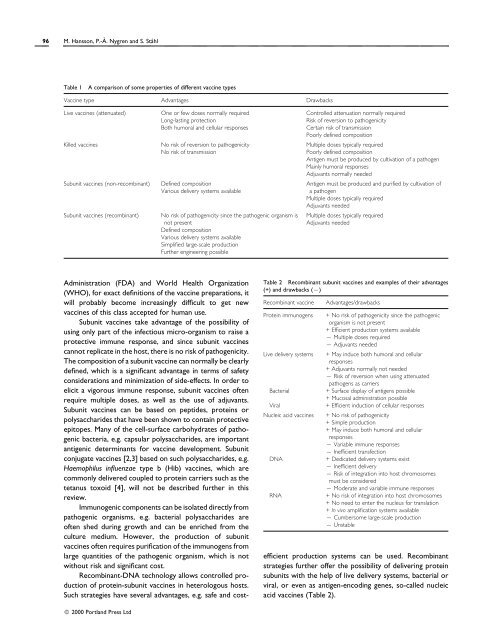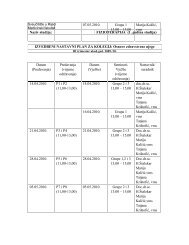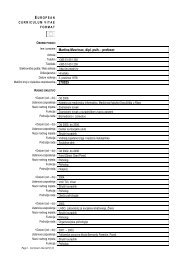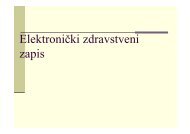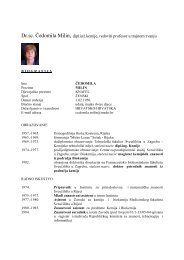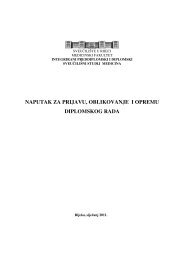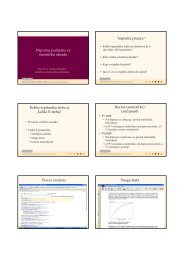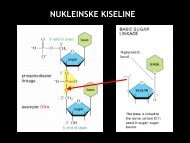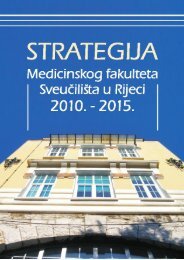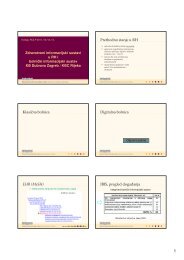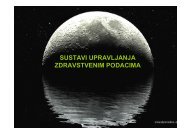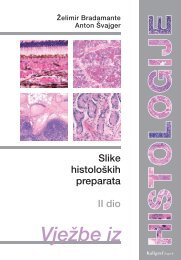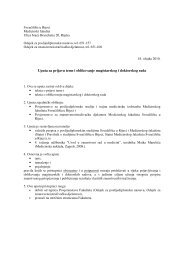REVIEW Design and production of recombinant subunit vaccines
REVIEW Design and production of recombinant subunit vaccines
REVIEW Design and production of recombinant subunit vaccines
Create successful ePaper yourself
Turn your PDF publications into a flip-book with our unique Google optimized e-Paper software.
96 M. Hansson, P.-A� . Nygren <strong>and</strong> S. Sta� hl<br />
Table 1 A comparison <strong>of</strong> some properties <strong>of</strong> different vaccine types<br />
Vaccine type Advantages Drawbacks<br />
Live <strong>vaccines</strong> (attenuated) One or few doses normally required Controlled attenuation normally required<br />
Long-lasting protection Risk <strong>of</strong> reversion to pathogenicity<br />
Both humoral <strong>and</strong> cellular responses Certain risk <strong>of</strong> transmission<br />
Poorly defined composition<br />
Killed <strong>vaccines</strong> No risk <strong>of</strong> reversion to pathogenicity Multiple doses typically required<br />
No risk <strong>of</strong> transmission Poorly defined composition<br />
Antigen must be produced by cultivation <strong>of</strong> a pathogen<br />
Mainly humoral responses<br />
Adjuvants normally needed<br />
Subunit <strong>vaccines</strong> (non-<strong>recombinant</strong>) Defined composition<br />
Various delivery systems available<br />
Subunit <strong>vaccines</strong> (<strong>recombinant</strong>) No risk <strong>of</strong> pathogenicity since the pathogenic organism is<br />
not present<br />
Defined composition<br />
Various delivery systems available<br />
Simplified large-scale <strong>production</strong><br />
Further engineering possible<br />
Administration (FDA) <strong>and</strong> World Health Organization<br />
(WHO), for exact definitions <strong>of</strong> the vaccine preparations, it<br />
will probably become increasingly difficult to get new<br />
<strong>vaccines</strong> <strong>of</strong> this class accepted for human use.<br />
Subunit <strong>vaccines</strong> take advantage <strong>of</strong> the possibility <strong>of</strong><br />
using only part <strong>of</strong> the infectious micro-organism to raise a<br />
protective immune response, <strong>and</strong> since <strong>subunit</strong> <strong>vaccines</strong><br />
cannot replicate in the host, there is no risk <strong>of</strong> pathogenicity.<br />
The composition <strong>of</strong> a <strong>subunit</strong> vaccine can normally be clearly<br />
defined, which is a significant advantage in terms <strong>of</strong> safety<br />
considerations <strong>and</strong> minimization <strong>of</strong> side-effects. In order to<br />
elicit a vigorous immune response, <strong>subunit</strong> <strong>vaccines</strong> <strong>of</strong>ten<br />
require multiple doses, as well as the use <strong>of</strong> adjuvants.<br />
Subunit <strong>vaccines</strong> can be based on peptides, proteins or<br />
polysaccharides that have been shown to contain protective<br />
epitopes. Many <strong>of</strong> the cell-surface carbohydrates <strong>of</strong> pathogenic<br />
bacteria, e.g. capsular polysaccharides, are important<br />
antigenic determinants for vaccine development. Subunit<br />
conjugate <strong>vaccines</strong> [2,3] based on such polysaccharides, e.g.<br />
Haemophilus influenzae type b (Hib) <strong>vaccines</strong>, which are<br />
commonly delivered coupled to protein carriers such as the<br />
tetanus toxoid [4], will not be described further in this<br />
review.<br />
Immunogenic components can be isolated directly from<br />
pathogenic organisms, e.g. bacterial polysaccharides are<br />
<strong>of</strong>ten shed during growth <strong>and</strong> can be enriched from the<br />
culture medium. However, the <strong>production</strong> <strong>of</strong> <strong>subunit</strong><br />
<strong>vaccines</strong> <strong>of</strong>ten requires purification <strong>of</strong> the immunogens from<br />
large quantities <strong>of</strong> the pathogenic organism, which is not<br />
without risk <strong>and</strong> significant cost.<br />
Recombinant-DNA technology allows controlled <strong>production</strong><br />
<strong>of</strong> protein-<strong>subunit</strong> <strong>vaccines</strong> in heterologous hosts.<br />
Such strategies have several advantages, e.g. safe <strong>and</strong> cost-<br />
� 2000 Portl<strong>and</strong> Press Ltd<br />
Antigen must be produced <strong>and</strong> purified by cultivation <strong>of</strong><br />
a pathogen<br />
Multiple doses typically required<br />
Adjuvants needed<br />
Multiple doses typically required<br />
Adjuvants needed<br />
Table 2 Recombinant <strong>subunit</strong> <strong>vaccines</strong> <strong>and</strong> examples <strong>of</strong> their advantages<br />
(+) <strong>and</strong> drawbacks (�)<br />
Recombinant vaccine Advantages/drawbacks<br />
Protein immunogens + No risk <strong>of</strong> pathogenicity since the pathogenic<br />
organism is not present<br />
+ Efficient <strong>production</strong> systems available<br />
� Multiple doses required<br />
� Adjuvants needed<br />
Live delivery systems + May induce both humoral <strong>and</strong> cellular<br />
responses<br />
+ Adjuvants normally not needed<br />
� Risk <strong>of</strong> reversion when using attenuated<br />
pathogens as carriers<br />
Bacterial + Surface display <strong>of</strong> antigens possible<br />
+ Mucosal administration possible<br />
Viral + Efficient induction <strong>of</strong> cellular responses<br />
Nucleic acid <strong>vaccines</strong> + No risk <strong>of</strong> pathogenicity<br />
+ Simple <strong>production</strong><br />
+ May induce both humoral <strong>and</strong> cellular<br />
responses<br />
� Variable immune responses<br />
� Inefficient transfection<br />
DNA + Dedicated delivery systems exist<br />
� Inefficient delivery<br />
� Risk <strong>of</strong> integration into host chromosomes<br />
must be considered<br />
� Moderate <strong>and</strong> variable immune responses<br />
RNA + No risk <strong>of</strong> integration into host chromosomes<br />
+ No need to enter the nucleus for translation<br />
+ In vivo amplification systems available<br />
� Cumbersome large-scale <strong>production</strong><br />
� Unstable<br />
efficient <strong>production</strong> systems can be used. Recombinant<br />
strategies further <strong>of</strong>fer the possibility <strong>of</strong> delivering protein<br />
<strong>subunit</strong>s with the help <strong>of</strong> live delivery systems, bacterial or<br />
viral, or even as antigen-encoding genes, so-called nucleic<br />
acid <strong>vaccines</strong> (Table 2).


